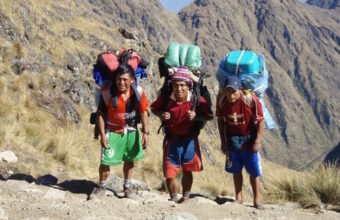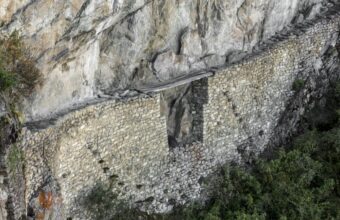Machu Picchu hikes
An expert guide to the Machu Picchu trek
While there are hundreds of fascinating ruins in Peru, the famed Machu Picchu has captured the hearts and imaginations of travellers around the world. For many, a trip to Peru isn’t complete without a Machu Picchu hike.
Your options for trekking to, or around, Machu Picchu are fairly straightforward:
- If you want to trek to Machu Picchu, and arrive at the ruins by foot, the only way to do this is via the Inca Trail, either the full four-day route or the KM 140 ('two-day' route).
- The tourism industry markets a variety of “alternative” Machu Picchu hikes. They're all excellent, but none of them actually arrive at the ruins by foot.
- Once you're in the site itself, there are a number of optional short Machu Picchu hikes, all of which must be booked in advance.
I've visited Machu Picchu ten times during my time working in Peru as a travel journalist. Over the years I've figured out the tricks, the secrets, and some harsh truths the mainstream tourism industry doesn't want to tell you. In the following pages I’ll break down the variety of Machu Picchu hikes and offer my personal advice on the various pros and cons of each.

View of Huayna Picchu, the classic Machu Picchu day hike
The best Machu Picchu hikes
The popular, and some lesser-known, treks
All of the following Machu Picchu hikes must be booked in advance – sometimes well in advance, depending on your chosen trek and time of travel – but in particular high demand are the two classic Inca Trail hikes. If you're not sold on the classic Inca Trail, the "alternative treks" are all excellent. Note that although these are often sold as Machu Picchu hikes, none of them actually arrive at the ruins by foot (see below). Not all these treks include archeological sites and there's a huge range of difficulty, so be sure to check what you’re signing up for before booking.
-
Inca Trail
-
Machu Picchu
-
Lares Valley
-
Choquequirao
-
Salkantay
-
Ausangate
-
Vilcabamba
-
Machu Picchu
-
Machu Picchu
-
Machu Picchu
-
Machu Picchu
-
Machu Picchu
-
Machu Picchu
-
Machu Picchu
Machu Picchu hikes: Need to know
Everything you wish you'd known before you booked
To Inca Trail or not?
The classic Inca Trail trek is deservedly popular, but its fame comes at a cost: this is one of the most sought-after treks on earth, the trail is busy year-round, and you must plan months in advance.
I’ve hiked the Inca Trail to Machu Picchu twice and definitely understand the allure, but I wouldn’t do it again. It’s just too busy and commoditised, and the way porters are treated is too problematic. Real changes must be made before I can recommend the Inca Trail without reservation. I usually recommend one of the alternative treks instead.
My favourite Inca Trail "alternative"
If it’s important for you to arrive at Machu Picchu by foot, consider doing the KM104 hike to Machu Picchu, which I’ve also done twice. You get the epic arrival with a less crowded experience.
A little-publicised benefit to the KM104 trek is that you arrive at Machu Picchu in the afternoon, as the crowds are beginning to thin out. You are not allowed to enter the ruins, but you have a great view of them from the Sun Gate (Intipunku) and can stop to take photos on some of the upper terraces. Even better, you return the next morning for a full guided tour.
My ultimate pro tip: combine the Lares trek for an uncrowded, rustic multi-day hiking experience, followed by the KM104 hike for the epic Machu Picchu arrival.
Alternative hikes "to" Machu Picchu
As a result of the classic Inca Trail’s popularity, a number of other treks in the Cusco region have emerged, commonly marketed as Inca Trail or Machu Picchu "alternative hikes."
It's important to note, though, that despite the tourism industry's best efforts to rewrite reality and sell these as alternative hikes “to” Machu Picchu, none of the most popular alternatives are technically treks to Machu Picchu. They all finish somewhere near the ruins, followed by a transfer to Aguas Calientes where you'll visit the ruins via train and bus with all the other day-trippers. The Inca Trail (classic or KM104) is the only route that actually arrives at Machu Picchu by foot.
However, if you’re willing to forego the Machu-Picchu-on-foot grand finale, the advantages of choosing an alternative hike are many: you can bypass the permit system and crowded campgrounds, and delve deeper into traditional Andean culture and more rustic mountain wilderness areas.
And with a higher budget, you can even skip the tent-trekking experience altogether and pamper yourself in the surprisingly refined mountain lodges to be found en route. There are no lodges on the Inca Trail.
Another important consideration is that porters are required on the Inca Trail, while other trails allow horses, mules and pack llamas. There are ongoing workers’ rights issues for Inca Trail porters, which do not necessarily apply to the muleteers and other support staff on alternative treks.
Hiking regulations
As you would expect with such popularity, tourism at the site is heavily regulated and tickets should be purchased well in advance. As of 2023, only 190 tickets are sold per hour from 6am to 1pm, with 194 available at 2pm to bring the total to 1,714 people per day. It seems that every year new restrictions are imposed or modified, so be sure you check the current regulations on the official government website.
In 2022 the government introduced five one-way circuits through the citadel to reduce the congestion in the most popular parts of the ruins. On the website above you can download maps for each of the different circuits. If you visit only the citadel, the main part of the ruins, you can choose circuits 1-4. When you buy Machu Picchu tickets, this is called “Llaqta de Machupicchu.” The Quechua word “llaqta” means town. Circuit 5 is for those who hike all or part of the Inca Trail. If you choose to add on any of the extra hikes described below, the circuit will be chosen for you.
Machu Picchu hiking FAQs
Your questions, our expert answers
Question
I’m not keen on touristy places, is Machu Picchu really a must-see in your opinion or should we go somewhere less popular?
Answer
I wouldn’t call Machu Picchu a must-see, especially if you don’t like crowds. That said, of all the Inca ruins near Cusco, Machu Picchu is the biggest that’s easiest to get to and has the most qualified guides who can tell you all about the site. Comparatively, the Inca ruins at Pisac are more accessible, cheaper and have fewer crowds but aren’t as big. Choquequirao is just as big and impressive but requires a long and challenging hike.
Question
What alternative to the Inca Trail do you most recommend, and why?
Answer
Personally, I like Lares the most because you get a real taste of indigenous Andean culture while staying close to Machu Picchu. If you want to do a challenging trek and see Inca archeology, but not necessarily Machu Picchu, go to Choquequirao.
Question
Is the Inca Trail realistic, say for someone in their 60s who is pretty fit and active?
Answer
Yes, if you acclimate to the altitude first. Every day somebody gets to the point that they can’t walk any more and a porter actually carries that person piggy-back. I don’t think that should be allowed, but it happens and you don’t want that to be you.
Question
What permits will I require?
Answer
As Machu Picchu grows in its renown as a destination, a permit system has been enforced in order to keep the sheer volume of travellers in check. Permits to the following sites are required, and can be found here. (Note, however, that the site’s language options are limited and the online payment portal is notoriously spotty). You can also pay directly at the offices in Cusco or Aguas Calientes, or have permits arranged through a reputable tour operator.
Inca Trail permits
The classic four-day Inca Trail route is strictly regulated by a permit system. The limit is 500 people per day, including guides and porters, and permits sell out months in advance. Any variation of this route (even the one-day “Km 104 hike”, which overlaps with the last stretch of the Inca Trail), requires a permit. The Inca Trail is closed for conservation work every February.
Machu Picchu permits
Entrance to the citadel itself is capped at 2,500 per day. While this limit is rarely reached, it’s better to reserve in advance — especially during the peak season and festivals.
Huayna Picchu permits
For a short but steep hike to the top of the peak hovering behind Machu Picchu (called Huayna Picchu), reserve in advance. This permit is added to the entrance ticket. Entrances are managed in waves of 75 people at 7am, 8am, 9am and 10am for a total of 300 people per day. Less popular is the hike up Machu Picchu Mountain, which is also permit-regulated and can also be added to the entrance ticket.
Question
We already have a ticket booked for Machu Picchu but would like to add on a hike to Huayna or Huchuy Picchu. Is there any way to add on tickets for either hike during our visit?
Answer
It is not possible to buy an individual ticket only for any of the Machu Picchu day hikes (Huayna Picchu, Huchuy Picchu, etc). Tickets for those add-on hikes must be chosen when you are buying your Machu Picchu entrance ticket. If your tour agency bought your Machu Picchu ticket, you need to ask them if they can return it for a refund and buy you another. Machu Picchu tickets are sold by the government and are normally non-refundable and non-transferrable. However, an agency might be able to make that change for you.
If you bought the ticket yourself, you should buy another one that includes the day hike. Then, when you're in Cusco you can go to the Machu Picchu ticket office on Plazoleta Regocijo and try to get a refund for the original ticket. I can't guarantee that they'll give you a refund.
Question
I'm 70 and reasonably fit but am concerned about altitude sickness on the Inca Trails. Is the risk higher on the short two day trail?
Answer
I'd say the Two Day Inca Trail is a much better choice if you're concerned about altitude. The highest point on the full (four day) Inca Trail is 4,215 metres but on the two day trail it's only 3,680 metres. That's still high, but on the two day trail you are at high altitude for much less time and you can sleep at lower altitude the night before. The full four day trek has you at about 4,000 metres for a long time, and that 4,215 metre high point isn't the only high pass you have to cross.
Obviously the longer you can acclimatise the better, I'd strongly advise against arriving and heading straight off onto the trek.
Most people acclimatise in Cusco, but at 3,500 metres the altitude sickness can be rough here too! I'd recommend spending a couple days before your hike in the Sacred Valley such as in Ollantaytambo, which is a much more manageable 2,792 metres.
None of this constitutes medical advice and if you have any concerns you should talk to a doctor first.
Question
We have a Machu Picchu entrance ticket at 7am and have to be back at Aguas Calientes for the 13:37 train. Would we have time to hike to Huchuy Picchu that morning?
Answer
It only takes about half an hour each way to hike Huchuy Picchu, so it's absolutely possible to do the hike, spend time at the top taking photos and get back down to Aguas Calientes. If you take the noon shuttle departing Machu Picchu, you should have time to buy take-out lunch in Aguas Calientes to eat on the 1:37 train.














































